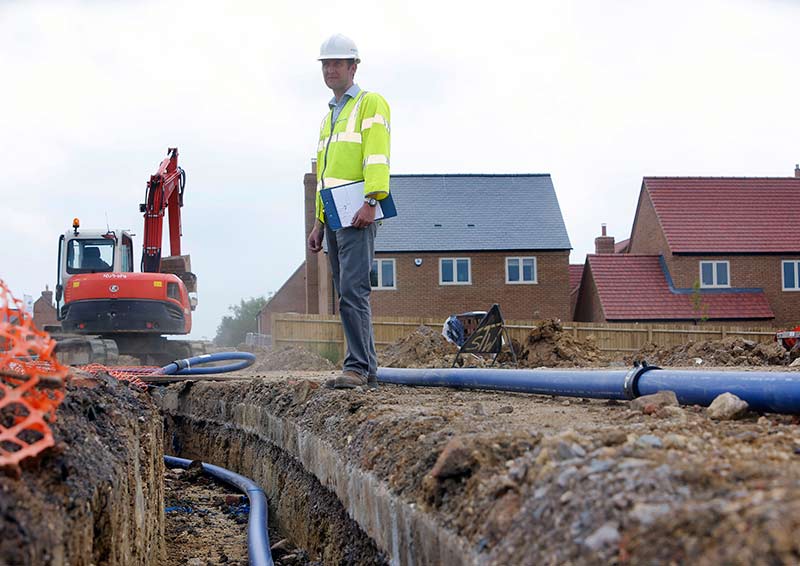Vital infrastructure and redevelopment
Christopher Hayton, Anglian Water Services (AWS) public affairs manager, examines the key role of vital infrastructure in growth and regeneration.
Contents |
[edit] Introduction
Towns and cities in the east of England are expanding and new urban centres are springing up. Even small rural communities are seeing new development.
All these new homes and businesses have to be supplied with water. The duty of a utilities provider goes further than merely putting in pipes and pumps. The sheer necessity of water gives them a platform from which to influence others and to help shape sustainable, resilient communities.
It is also a duty to enable sustainable growth, to help future-proof regions against challenges like population growth and climate change, so communities can flourish and businesses can thrive.
The same is true for other infrastructure providers. All have a duty to help society adapt to change and a real opportunity to re-imagine both physical and digital places.
[edit] No more mobile ‘not spots’
Much of AWS's workforce is spread over a huge, rural area, so good broadband speeds and a reliable mobile signal really matter.
Like many businesses and communities in the region, AWS struggle with mobile ‘not spots', so when changing mobile provider they made increasing levels of coverage to the region a condition of winning the contract.
AWS's people in the field now get better coverage and so do their customers. AWS used their procurement process to encourage investment and an improved service for the whole region.
[edit] Help to improve roads and rail
Our influence is also helping to improve transport links. We need a reliable road network if we are to keep our own network of pipes, pumps and treatment works running smoothly. Sampling and maintenance work takes our employees to thousands of sites scattered across an operating area that covers 27,500 sq. km.
But good transport links benefit everyone. They make our region better connected and more productive. So we’ve involved ourselves with local enterprise partnerships, businesses, communities and local authorities to – if you’ll pardon the pun – drive improvements to road and rail.
For example, our group director of corporate affairs chairs the New Anglia LEP, championing causes that include Norwich in 90 and No More A14 Delays in Suffolk. And we’re working hard to reduce the impact of our own streetworks on people’s journeys. Infrastructure should help and not hinder.
[edit] Wisbech Garden City Vision
All of these things come together in Wisbech, where Anglian Water is playing a key role in regenerating a town that has been left behind in terms of economic development.
We are a driving force behind the Wisbech Garden City Vision, which aims to build 10,000 new homes and to bring the railway back to the town for the first time in nearly 50 years.
This is the Fens and much of the development would be on land vulnerable to flooding. We want to show how this barrier can be overcome with innovative flood mitigation like sustainable drainage (SuDS) and better surface water management.
SuDS and green space can reduce flood risk. They would also enhance the environment and benefit the people – our customers – who live in Wisbech. But this scheme would also show how they can unlock large scale, sustainable development.
The world is changing and infrastructure providers must change too. It is no longer enough for to continue with traditional, introverted and incremental ways of doing business. We need to have a global perspective and to place communities, the environment and the economy at the heart of our thinking and planning.
This article was originally published here by ICE on 7th March 2017. It was written by Christopher Hayton, Anglian Water Services (AWS) public affairs manager.
--The Institution of Civil Engineers
[edit] Related articles on Designing Buildings Wiki
- Articles by ICE on Designing Buildings Wiki.
- Government construction and infrastructure pipelines.
- Highway drainage.
- How to connect unconnected vehicles.
- Infrastructure and cyber attacks.
- Pipelines.
- Rural broadband.
- Sewer construction.
- Sustainable urban drainage systems SUDS.
- Systems thinking.
- The future of green infrastructure.
Featured articles and news
A change to adoptive architecture
Effects of global weather warming on architectural detailing, material choice and human interaction.
How big is the problem and what can we do to mitigate the effects?
Overheating guidance and tools for building designers
A number of cool guides to help with the heat.
The UK's Modern Industrial Strategy: A 10 year plan
Previous consultation criticism, current key elements and general support with some persisting reservations.
Building Safety Regulator reforms
New roles, new staff and a new fast track service pave the way for a single construction regulator.
Architectural Technologist CPDs and Communications
CIAT CPD… and how you can do it!
Cooling centres and cool spaces
Managing extreme heat in cities by directing the public to places for heat stress relief and water sources.
Winter gardens: A brief history and warm variations
Extending the season with glass in different forms and terms.
Restoring Great Yarmouth's Winter Gardens
Transforming one of the least sustainable constructions imaginable.
Construction Skills Mission Board launch sector drive
Newly formed government and industry collaboration set strategy for recruiting an additional 100,000 construction workers a year.
New Architects Code comes into effect in September 2025
ARB Architects Code of Conduct and Practice available with ongoing consultation regarding guidance.
Welsh Skills Body (Medr) launches ambitious plan
The new skills body brings together funding and regulation of tertiary education and research for the devolved nation.
Paul Gandy FCIOB announced as next CIOB President
Former Tilbury Douglas CEO takes helm.
UK Infrastructure: A 10 Year Strategy. In brief with reactions
With the National Infrastructure and Service Transformation Authority (NISTA).
Ebenezer Howard: inventor of the garden city. Book review.
Airtightness Topic Guide BSRIA TG 27/2025
Explaining the basics of airtightness, what it is, why it's important, when it's required and how it's carried out.























